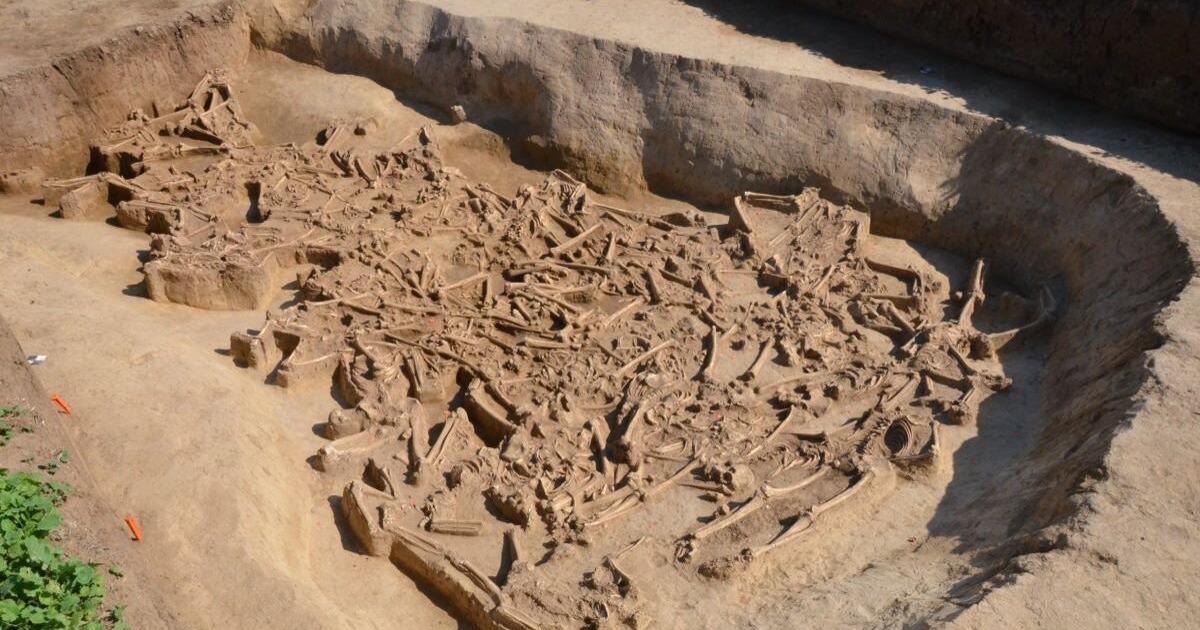The gruesome find dates back to the Stone Age.
In the municipality of Vráble, in Slovakia, about 80 kilometers from Bratislava, the last excavation campaign of a Slovak-German archaeological mission unearthed a large pit filled with a tide of human bones.
Until now, the site studied gave researchers the image of a large Neolithic housing estate without history, with its dozens of huts, its palisade, its ordered burials.
The village, however, hid the remains of a hecatomb.
Archaeologists from the Slovak Academy of Sciences and the University of Kiel counted, this summer, at least thirty-five skeletons in the fatal hollow of the earth.
The number of corpses must have been higher.
Hastily dumped into the pit, the bodies were found on their backs, stomachs, sides, rolled up in a fetal position, without any care.
And headless.
“All identified individuals were beheaded, we only found a child's skull on the spot,”
Slovak archaeo-anthropologist Zuzana Hukeľová said in a statement from the Academy of Sciences in September.
Read alsoIn Germany, discovery of a folding metal chair in the tomb of a woman who died in the Middle Ages
This pit therefore corresponds to a collective burial of individuals who died at the same time, for a still unknown reason, around 5250-4950 BC.
According to the first anthropological examinations, the majority of the deceased were minors.
Some showed signs of wounds from before their brutal end.
This summer, the international mission completed its seventh excavation campaign on the prehistoric site of Vráble.
Ivan Cheben/Matej Ruttkay/AÚ SAV
However, the hypothesis of an execution by detachment is not yet certain at this stage, especially since post-mortem decapitation has been practiced and observed on other burials in Vráble.
On the other hand, little funerary material has been identified in the bottom of the pit;
among the rare objects found, archaeologists have for example discovered human teeth, drilled - perhaps an amulet.
Read alsoSkeletons discovered in England, victims of an anti-Semitic massacre in the Middle Ages
Birth of extreme violence
Post-excavation studies should allow the scientific team to learn more about the mass grave.
Were the individuals put to death by decapitation, or was it a funeral rite performed after the passage of a devastating epidemic?
Were they related?
These questions are of great interest to Slovak and German archaeologists who study the site of Vráble, a large village spread over three housing estates covering some 50 hectares and known as a local Bronze Age mecca.
The first phases of occupation of this proto-agglomeration could precisely be clarified by the study of the uncovered burial.
Read alsoFrom armed parades to the presentation of the eagles: diving into the Imperial Jubilee
The discoveries of mass graves follow one another in Europe and begin to form a rich corpus of the horrors of the Stone Age.
Exhumed in 2006, twenty-six individuals were killed with extreme violence, around 5000 BC, in Schöneck-Kilianstädten (Germany).
In Achenheim (Alsace), about fifteen men were dismembered around 4200 BC.
In Talheim, near Stuttgart, thirty-four dead, including sixteen children.
In Schletz (Austria), at least sixty mutilated slaughtered.
Or Potočani (Croatia), forty victims of prehistoric carnage.
What does this sudden onslaught of violence correspond to in the middle of the Neolithic?
In Europe, the human groups of this period settled down with the appearance of agriculture.
This period which stretches from the 6th to the 3rd millennium BC.
J.-C., is marked by the growing hierarchy of populations and an increase in conflicts.
"We have gone from the image of a hardworking and peaceful world to that of a world where violence was not absent"
, summarized in 2015 in
Figaro
Jean Guilaine, professor emeritus at the College de France.
This “clockwork orange” pivot of the Neolithic period can be seen in particular by the appearance of fortifications on the sites, like the wooden palisade discovered at Vráble, coupled with a defensive ditch.
A fortification which, however, did not always prevent massacres.

